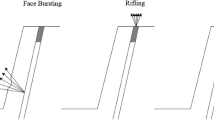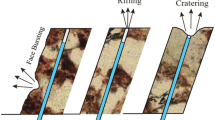Abstract
Drilling and blasting is the predominant rock fragmentation method in open-cast mines and civil construction works. Flyrock is one of the most hazardous effects caused by blasting operation. Therefore, the ability to make accurate predictions of the blast-induced flyrock is essential to reduce the environmental problems. This paper aimed to develop a precise and applicable model based on regression tree (RT) to predict blast-produced flyrock distance in Ulu Tiram quarry, Malaysia. In this regard, 65 blasting operations were investigated and the most influential factors on the flyrock, i.e. blast-hole length, spacing, burden, stemming, maximum charge used per delay and powder factor, were measured. Also, the flyrock distance values for the considered blasting events were carefully measured. In order to check the precision of the proposed RT model, multiple linear regression (MLR) model was also developed and both of the predictive models were compared. For this work, some statistical functions, i.e. median absolute error, coefficient of determination (R 2) and root mean squared error, were used and computed. The results revealed that the RT can be introduced as a powerful technique to predict flyrock distance and the proposed RT model can estimate flyrock distance better than MLR model. Also, sensitivity analysis was performed and it was found that the powder factor is the most influential parameter on the flyrock in the studied case.







Similar content being viewed by others
References
Adhikari GR (1999) Studies on flyrock at limestone quarries. Rock Mech Rock Eng 32:291–301
Bajpayee TS, Rehak TR, Mowrey GL, Ingram DK (2004) Blasting injuries in surface mining with emphasis on flyrock and blast area security. J Safe Res 35:47–57
Berta G (1990) Explosives: an engineering tool. Italesplosivi, Millano
Bhandari S (1997) Engineering rock blasting operations. Taylor & Francis, Boca Raton
Breiman L, Freidman J, Olshen R, Stone C (1984) Classification and regression trees. Wadsworth, Belmont
Ebrahimi E, Monjezi M, Khalesi MR, Jahed Armaghani D (2015) Prediction and optimization of back-break and rock fragmentation using an artificial neural network and a bee colony algorithm. Bull Eng Geol Environ. doi:10.1007/s10064-015-0720-2
Ghasemi E, Sari M, Ataei M (2012) Development of an empirical model for predicting the effects of controllable blasting parameters on flyrock distance in surface mines. Int J Rock Mech Min Sci 52:163–170
Ghasemi E, Amini H, Ataei M, Khalokakaei R (2014) Application of artificial intelligence techniques for predicting the flyrock distance caused by blasting operation. Arab J Geosci 7:193–202
Gupta RN (1980) Surface blasting and its impact on environment. In: Trivedy NJ, Singh BP (eds) Impact of mining on environment. Ashish Publishing House, New Delhi, pp 23–24
Hajihassani M, Jahed Armaghani D, Sohaei H, Tonnizam Mohamad E, Marto A (2014) Prediction of airblast-overpressure induced by blasting using a hybrid artificial neural network and particle swarm optimization. Appl Acoust 80:57–67
Hasanipanah M, Monjezi M, Shahnazar A, Jahed Armaghanid D, Farazmand A (2015) Feasibility of indirect determination of blast induced ground vibration based on support vector machine. Measurement 75:289–297
Hustrulid WA (1999) Blasting principles for open pit mining: vol 1, general design concepts. Balkema, Rotterdam
Institute of Makers of Explosives (IME) (1997) Glossary of commercial explosive industry terms, safety publication No. 12. Institute of Makers of Explosives, Safety Publication, Washington DC, p 16
Jahed Armaghani D, Hajihassani M, Mohamad ET, Marto A, Noorani SA (2014) Blasting-induced flyrock and ground vibration prediction through an expert artificial neural network based on particle swarm optimization. Arab J Geosci 7:5383–5396
Jahed Armaghani D, Hasanipanah M, Tonnizam Mohamad E (2016) A combination of the ICA-ANN model to predict air-overpressure resulting from blasting. Eng Comput 32:155–171
Kecojevic V, Radomsky M (2005) Flyrock phenomena and area security in blasting-related accidents. Safe Sci 43:739–750
Khandelwal M, Monjezi M (2013) Prediction of flyrock in open pit blasting operation using machine learning method. Int J Min Sci Tech 23:313–316
Khandelwal M, Singh TN (2007) Evaluation of blast-induced ground vibration predictors. Soil Dyn Earthq Eng 27:116–125
Lewis RJ (2000) An introduction to classification and regression tree (CART) analysis. In: Annual meeting of the society for academic emergency medicine in San Francisco, California, pp 1–14
Little TN, Blair DP (2010) Mechanistic Monte Carlo models for analysis of flyrock risk. Rock fragmentation by blasting. Taylor and Francis, London, pp 641–647
Lundborg N, Persson N, Ladegaard-Pedersen A, Holmberg R (1975) Keeping the lid on flyrock in open pit blasting. Eng Min J 176:95–100
Marto A, Hajihassani M, Jahed Armaghani D, Tonnizam Mohamad E, Makhtar AM (2014) A novel approach for blast-induced flyrock prediction based on imperialist competitive algorithm and artificial neural network. The Sci World J 2014:11. doi:10.1155/2014/643715
Monjezi M, Khoshalan HA, Varjani AY (2012) Prediction of flyrock and backbreak in open pit blasting operation: a neurogenetic approach. Arab J Geosci 5:441–448
Monjezi M, Hasanipanah M, Khandelwal M (2013a) Evaluation and prediction of blast-induced ground vibration at Shur River Dam, Iran, by artificial neural network. Neural Comput Appl 22:1637–1643
Monjezi M, Mehrdanesh A, Malek A, Khandelwal M (2013b) Evaluation of effect of blast design parameters on flyrock using artificial neural networks. Neural Comput Appl 23:349–356
Raina AK, Murthy VMSR, Soni AK (2014) Flyrock in bench blasting: a comprehensive review. Bull Eng Geol Environ 73:1199–1209
Razi MA, Athappilly K (2005) A comparative predictive analysis of neural networks (NNs), nonlinear regression and classification and regression tree (CART) models. Expert Syst Appl 29:65–74
Rezaei M, Monjezi M, Yazdian Varjani A (2011) Development of a fuzzy model to predict flyrock in surface mining. Safe Sci 49:298–305
Roth JA (1979) A model for the determination of flyrock range as a function of shot condition. US department of commerce. NTIS report no, PB81222358
Roy PP (2005) Rock blasting effects and operations. Taylor & Francis, Boca Raton
Shirani Faradonbeh R, Jahed Armaghani D, Monjezi M (2016) Development of a new model for predicting flyrock distance in quarry blasting: a genetic programming technique. Bull Eng Geol Environ 75:993–1006. doi:10.1007/s10064-016-0872-8
SPSS Inc (2007) SPSS for windows (version 16.0). SPSS Inc, Chicago
Sut N, Simsek O (2011) Comparison of regression tree data mining methods for prediction of mortality in head injury. Expert Syst Appl 38:15534–15539
Swingler K (1996) Applying neural networks: a practical guide. Academic Press, New York
Tiryaki B (2008) Predicting intact rock strength for mechanical excavation using multivariate statistics, artificial neural networks, and regression trees. Eng Geol 99:51–60
Tiryaki B (2009) Estimating rock cuttability using regression trees and artificial neural networks. Rock Mech Rock Eng 42:939–946
Tomczyk AM, Ewertowski M (2013) Planning of recreational trails in protected areas: application of regression tree analysis and geographic information systems. Appl Geogr 40:129–139
Trivedi R, Singh TN, Raina AK (2014) Prediction of blast-induced flyrock in Indian limestone mines using neural networks. J Rock Mech Geotech Eng 6:447–454
Trivedi R, Singh TN, Gupta N (2015) Prediction of blast-induced flyrock in opencast mines using ANN and ANFIS. Geotech Geol Eng 33:875–891
Vega FA, Matías JM, Andrade ML, Reigosa MJ, Covelo EF (2009) Classification and regression trees (CARTs) for modelling the sorption and retention of heavy metals by soil. J Hazard Mater 167:615–624
Yang Y, Zang O (1997) A hierarchical analysis for rock engineering using artificial neural networks. Rock Mech Rock Eng 30:207–222
Author information
Authors and Affiliations
Corresponding author
Rights and permissions
About this article
Cite this article
Hasanipanah, M., Faradonbeh, R.S., Armaghani, D.J. et al. Development of a precise model for prediction of blast-induced flyrock using regression tree technique. Environ Earth Sci 76, 27 (2017). https://doi.org/10.1007/s12665-016-6335-5
Received:
Accepted:
Published:
DOI: https://doi.org/10.1007/s12665-016-6335-5




